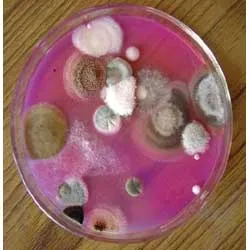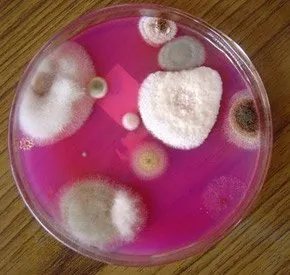by Dr. Anand Titus and Geeta N. Pereira
Fungi are the most dominant group of microorganisms in soil. The primary role of fungi in coffee plantations is to degrade the vast amounts of complex organic molecules generated from time to time due to the addition of mature plant residues, green manures, organic manures, leaf litter, and convert them into simpler compounds necessary for plant growth and development. Coffee farmers need to understand that most of the biomass available on the coffee farm is relatively free from toxic materials and can be used as stimulants for growth and development of beneficial fungi.
This paper focuses on the essential role that fungi, play as agents of organic matter decomposition in Coffee Agroforestry. In agricultural and environmental contexts, the term “decomposition” often carries negative connotations. Many planters and farmers, especially in regions where crops like coffee are grown, view decay as something undesirable, associated with rotting or waste. However, it is crucial to challenge this perspective and recognize that decomposition is not just a necessary process but a cornerstone of healthy ecosystems, particularly in the context of coffee farming. Fungi are the main decomposers in many ecosystems, particularly in coffee forests. They help release nitrogen and phosphorus from dead decaying matter through specialized proteins and enzymes in their cell walls and hyphae. Fungi are particularly suited to penetrate large pieces of matter like wood with their hyphae and break it down with lignin digesting enzymes.

Fungal Mycelium Network
The underground portion of Fungi, called the mycelium, is made up of a network of threadlike fibres called hyphae that can extend for miles. These hyphae can extend far into their surroundings, forming extensive networks known as mycelium. Mycelium plays a critical role in decomposing organic matter by physically breaking it down and absorbing the resulting nutrients.
Decomposition
Fungi are primary decomposers in terrestrial ecosystems, breaking down complex organic materials such as plant litter, dead animals, and other organic matter. This decomposition process is crucial for nutrient cycling, as it transforms organic matter into inorganic nutrients that plants can absorb.
Decomposition is a natural process by which organic matter, such as dead plants, leaves, and animal remains, is broken down by microorganisms and fungi. This process might seem unpleasant at first glance, but it is essential for the cycle of life in nature. When organic matter breaks down, it is converted into simpler compounds, enriching the soil and providing essential nutrients for new plants to thrive. This process is at the heart of nutrient cycling in any ecosystem, as it ensures that nutrients like nitrogen, phosphorus, and potassium are returned to the soil, making them available to plants again.
Enzymatic Action
Fungi secrete a variety of enzymes that degrade complex organic compounds into simpler forms. For instance, lignin-degrading fungi can break down lignin in wood, while cellulolytic fungi target cellulose. This enzymatic action releases essential nutrients such as nitrogen, phosphorus, and potassium back into the soil, making them available for plant uptake. Fungi secrete enzymes that can break down complex organic compounds like carbohydrates and proteins into simpler components with the release of energy. These fungal decomposers, alongside their saprobic bacterial allies, provide a vital role in releasing scarce, yet biologically-essential elements, such as nitrogen and phosphorus, from decaying matter. Their mode of nutrition, which involves digestion before ingestion, allows fungi to degrade many large and insoluble molecules that would otherwise remain trapped in a habitat. This role is vital for the recycling of nutrients into the larger community. This ability is especially important in ecosystems like coffee plantations, where the decomposition of organic material, such as fallen coffee cherries, leaves, and other plant matter, enriches the soil and maintains the health of the plantation.
Nutrient Mineralization
As fungi decompose organic matter, they contribute to the mineralization of nutrients. This process involves converting organic forms of nutrients into inorganic forms that are accessible to plants. For example, nitrogen is released in the form of ammonium or nitrate, while phosphorus is often released as soluble phosphates.
Soil Structure Improvement
Fungal hyphae contribute to soil aggregation, which enhances soil structure and stability. Improved soil structure facilitates better water retention and aeration, further promoting nutrient availability and root growth.
Symbiotic Relationships with Plants
Fungi often form symbiotic relationships with plants, significantly enhancing nutrient acquisition.
Sub Processes of Fungal Decomposition

Decomposition is a complex process made up of several sub-processes. First, leaves and other organic matter are broken down into smaller pieces in a process called fragmentation. This increases the surface area to support the growth of bacteria and fungi, as smaller fragments are easier for microbes to colonize. Rainwater then percolates through the leaf litter, dissolving and carrying away some of the chemicals in a process called leaching. The movements of soil animals stir the leaf fragments and mineral soil particles together, a process called bioturbation. The result of these interactions can be seen in the changes to the leaves – they are reduced to small dark brown shreds as fungi heavily colonize the fragments.
The Process of Fungal Decomposition
Finally, at the end of decomposition, the leaves have become fine black particles of soil organic matter, with their original shape no longer recognizable. The speed of decomposition depends on temperature, moisture, and the chemical composition of the organic matter. If the temperature is too low or high, fungi and bacteria cannot grow well and the rate of decomposition slows. If the leaves have a low nitrogen content, decomposition is also slowed because fungi and bacteria cannot extract enough nitrogen to make the proteins they need for growth.
Oxygen levels are another important factor, as fungi require oxygen. In low oxygen environments like lakes, fungal growth and decomposition will be slower. If decomposition could not occur, the nitrogen in dead organic matter would remain locked up and plant growth would decrease over time as the nitrogen is not replaced. This would be catastrophic for the food supply, as plant growth provides all of our food directly and indirectly through animals.
The Role of Fungi in Nutrient Cycling
Decomposition of organic matter is a central process of nutrient cycling which ends with the mineralization of nutrients like nitrogen and phosphorus. The element ratios of organic matter have been investigated as important controls of decomposition, especially in litter decomposition studies.
However, only a few studies have considered the stoichiometry of the decomposer communities and the internal cycling of elements in the microbial biomass. These show that organic C, N and P mineralization and immobilization in the microbial biomass is strongly determined by the relationship between the substrate stoichiometry and the microbial biomass stoichiometry. The critical substrate C:N and C:P ratio at which decomposers shift from being C-limited to being nutrient-limited is called the threshold element ratio (TER). When microorganisms decompose substrate with a C:N or C:P ratio beyond their TER, N and P are taken up into the microbial biomass, while below the TER net mineralization occurs. In agreement with these theoretical considerations, studies have shown that the stoichiometry of forest litter strongly affects rates of net organic C, N and P mineralization, gross organic C, N and P mineralization, and organic C mineralization per unit microbial biomass. The turnover times of C and nutrients in the microbial biomass are also important factors controlling decomposition rates. From the perspective of coffee farming, fungi help to create a fertile environment where the coffee plants can thrive. These decomposers break down plant material into humus, a rich organic substance that enhances the soil’s structure, water retention, and nutrient content. Moreover, the presence of mushrooms in the soil indicates a healthy, balanced ecosystem. Fungi also interact with plant roots in a symbiotic relationship called mycorrhizal association, where they provide nutrients to plants in exchange for sugars produced by the plants through photosynthesis. This relationship is crucial in coffee cultivation, as it enhances the plants’ resistance to disease and helps them better absorb nutrients, particularly in the often nutrient-poor soils found in coffee-growing regions. Without mushrooms and fungi, the nutrient cycle would slow down, and plants, including coffee trees, would struggle to access the resources they need for growth.
Conclusion
In conclusion, this paper underscores the importance of shifting the mindset surrounding decomposition and decay. Rather than seeing them as negative, planters—especially those in the coffee industry—should recognize them as vital processes that contribute to the health of the soil, the balance of nutrients, and the overall sustainability of the farm. Mushrooms, as active agents of decomposition, are not just participants in this process—they are integral players in maintaining the energy flow and nutrient cycles that sustain the coffee ecosystem.
References
Anand T Pereira and Geeta N Pereira. 2009. Shade Grown Ecofriendly Indian Coffee. Volume-1.
Alexander M. 1977. Introduction to soil microbiology (2nd ed.). NewYork: John Wiley,
Anand Titus Pereira & Gowda. T.K.S. 1991. Occurrence and distribution of hydrogen dependent chemolithotrophic nitrogen fixing bacteria in the endorhizosphere of wetland rice varieties grown under different Agro climatic Regions of Karnataka. (Eds. Dutta. S. K. and Charles Sloger. U.S.A.) In Biological Nitrogen Fixation Associated with Rice production. Oxford and I.B.H. Publishing. Co. Pvt. Ltd. India.